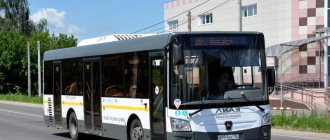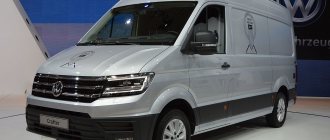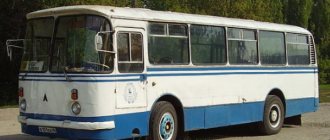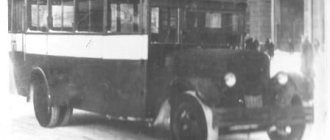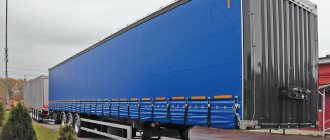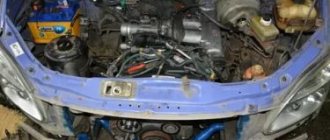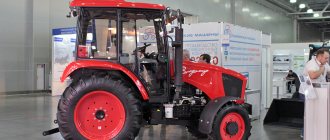Bus LAZ-699. Photo Wikipedia
LAZ-699 is a Soviet and Ukrainian large-class intercity bus, produced by the Lviv Bus Plant since 1964. Unlike the basic model of the Lvov ]LAZ-695[/anchor], the “699th” was extended by one section and was distinguished by a higher degree of comfort . In its configuration, it had a refrigerator, a compartment for thermoses, a wardrobe, a toilet, two large sliding sunroofs and 34 soft, adjustable passenger seats with radio speakers mounted in the headrest. The bus had a V-shaped ZIL-375 engine with a single-disc clutch and a synchronized manual gearbox, air suspension, independent for the front wheels, power steering, pneumatic brakes with separate circuits for the front and rear axles.
History of creation, description and device
In December 1960, after more than six months of lull, the design bureau and the experimental workshop of the LAZ plant, closing the reporting year, presented three new buses at once : the intercity LAZ-698 “Karpaty” with a one-and-a-half-story layout, the experimental LAZ-699 “Karpaty-2” (No. 20- E) and LAZ-699A “Karpaty” Experienced II (No. 22-E). Considering that the models were assembled in parallel, many of the new original solutions were applied to all copies at once.
Let’s take a closer look at the first experimental LAZ-699 “Karpaty-2” (No. 20-E). It became a logical continuation of the modernization of tourist models, in particular the LAZ-697. Modernization, first of all, in terms of improving the convenience of passenger seats and the quality of passenger transportation. The presence of the name “Karpaty” in the designation of the model meant that it belonged to luxury buses . According to the design bureau's idea, this airliner was to be operated only in intercity mode - long-distance travel on interregional routes and for international transport.
Intercity bus LAZ-699. Photo Wikipedia
Based on the conditions set, the comfort requirements were appropriate. In the back part there was a toilet and a wardrobe for outerwear. In the front part, next to the driver, there was a buffet , which included a compartment for thermoses and a refrigerator. The conductor's (stewardess) seat was also located near the driver. On the ceiling, instead of traditional incandescent lamps, there were fluorescent lamps.
There were 34 seats. Each of them was equipped with a soft, tilt-adjustable and ergonomic passenger seat . The high backrests contained headphones connected to the conductor's radio. Individual lighting lamps were also installed on the backs of the seats . There are curtains on the windows and glazed roof slopes. A custom ashtray, bottle holders, a bag for magazines and newspapers, and a removable table completed the picture.
Two large sliding sunroofs were supposed to provide adequate ventilation of the cabin when traveling in hot climates. The heating system was also taken care of. There were two of them : a standard heater for all LAZ buses; and as an additional one - the OV95 heating and ventilation unit, which operated independently of the engine. To store things under the floor, a luggage compartment with a total capacity of 4.5 m³ was equipped, while the permissible luggage allowance was 20 kg for each passenger.
The single-door all-metal body was increased by one window section (1345 mm), and its overall length was 10565 mm. Of course, for this, the design of the machine frame had to be revised and strengthened. The eight-cylinder V-shaped overhead valve carburetor engine ZIL-375 (7 l, 180 hp) with a single-disc clutch was chosen as the power unit It was traditionally located at the rear, and they did a good job of sealing it from the passenger compartment - sound insulation was at the proper level.
The gearbox is a five-speed, three-way synchronized mechanical type. An advanced brake system with pneumatic booster and separate drive, air wheel suspension and power steering greatly facilitated the driver's work and increased travel safety. Another technical innovation from the designers of the Lvov Design Bureau, which was hidden from prying eyes, was the installation of two gas tanks , which made it possible to significantly increase the duration of one flight without refueling. The maximum speed of the liner was 96 km/h.
The designers also worked on the factory emblem - a mesh for air intake is harmoniously located in its lower part. The paint scheme was three-color with an individual pattern, the outline of which in the upper part of the bus shirt was framed by a molding.
Modifications: “tourist”, “luxury”, 699R and others
LAZ-699A. In December 1960, two copies of the LAZ-699A Karpaty were ready, which were structurally completely consistent with the previous copy, with the exception of the pneumoelectric remote gear shift system installed on one of them, but, most importantly, these copies differed from the LAZ-699 in the interior layout . The installation of a buffet, wardrobe and toilet on the buses was abandoned, and due to the freed up space, the number of seats was increased to 41 . In addition, two additional jump seats could be placed in the front. Subsequently, this layout was accepted as the basic one, and then all experimental buses were made in the LAZ-699A modification.
Bus LAZ-699. Photo Wikipedia
Externally, the new buses also differed from the original version - the four-headlight road lighting system is noteworthy, and the headlights were installed one above the other, the moldings on the sides of the body were located differently, and, of course, the “two-story” emblem on one of the buses (namely that itself, with an installed pneumoelectric system; it can also be distinguished by its round wheel arches, while in another example the front arch had a noticeable cut in the upper part).
In 1961, several more prototypes of the LAZ-699A were produced. They retained the four-headlight lighting system , but the headlights were located more conventionally - horizontally. State tests of the buses took place in Crimea, but during the tests complaints arose about the reliability of some units, including the reliability of bridges. Therefore, the planned serial production of the LAZ-699A for 1962 had to be postponed until the comments of the state commission were corrected.
, a significantly modernized version of the LAZ-699A “Karpaty-1” was built in 1963 . The bus was specially prepared for additional state tests, in particular, more reliable axles from the MAZ-500 truck were installed on it, which made it possible to solve the problem of durability of the units , which were the main complaints about the tests. This bus still retained the four-headlight lighting system, but it was the last four-headlight LAZ-699.
Serial production of large intercity buses at the Lviv Bus Plant began under the name LAZ-699A “Tourist” in 1964. On serial buses there were no buffets, wardrobes and toilets - in this regard, the bus was simplified as much as possible, but it was equipped with a ZIL-375 engine with a power of 180 hp. The number of seats on the bus is 41. Interestingly, buses with two types of roofs were produced at the same time - with a rigid all-metal roof and with a roof with a canvas hatch. Production lasted only two years, after which the bus was discontinued, mainly due to problems with the reliability of the body. During these two years, not very many LAZ-699A buses were manufactured, and even in the late 60s they were not often seen on the roads.
In the spring of 1967, specifically for participation in the International Bus Competition in Nice and the 15th Tourist Bus Rally on European roads, the LAZ-699A was prepared, which was somewhat different in appearance and configuration from the serial ones. This bus, together with the LAZ "Ukraine-67", received Grand Prizes and medals from the French Commissariat of Tourism.
LAZ-699N. At the end of the 60s, specialists from the Head Specialized Design Bureau for Buses (GSKB) developed a new modified body for the LAZ-695N and LAZ-697N buses, externally different from previous modifications in a more modern design and high windshields. On its basis, in 1969, an experimental bus LAZ-699N was created , the body of which differed from the previous modification LAZ-699A in increased strength. This bus also has an emergency exit door in the rear overhang , which from now on becomes mandatory for all subsequent buses of the LAZ-699 family. The experimental LAZ-699N differed from future production vehicles in the absence of an air intake on the roof - accordingly, each side window had sliding windows, like the previous modification and the city models.
Long-distance bus LAZ-699. Photo Wikipedia
The following prototypes of the LAZ-699N "Tourist" appeared in 1972. One of these buses was exhibited at the USSR Exhibition of Economic Achievements in 1973. In 1973, experimental LAZ-699N with a natural ventilation system . There was an air intake on the roof of this bus, and there were no windows in the windows. These cars went into production two years later - in 1975. The serial LAZ-699N was produced from 1975 to 1978. in limited quantities.
In the 70s, a number of modifications and even individual models were created on the basis of the LAZ-699N bus.
In the early 70s, based on the LAZ-699N, GSKB produced experimental buses “Ukraine-71” and “Ukraine-73”, which were distinguished by an increased level of comfort . The Ukraine-71 bus was manufactured in two copies in 1971. Outwardly, it was in many ways similar to the familiar LAZ-699N and LAZ-699R, but in terms of comfort it was in many ways superior to future production models . The LAZ "Ukraine-71" provided passengers with two televisions, a tape recorder, a radio, a wardrobe, a buffet bar, a refrigerator, a coffee maker, a gas stove and a toilet. Each passenger seat, adjustable in backrest and width, had individual lighting and ventilation. “Ukraine-71” was equipped with a ZIL-375YA5 carburetor engine with a power of 180 hp, a clutch with pneumatic boosters, a dual-circuit braking system, and air wheel suspension with telescopic shock absorbers.
Two years later, another experimental bus appeared - “Ukraine-73”. It was an even more comfortable airliner than the 1971 Ukraine. The floor level of the passenger compartment was slightly raised relative to the driver's cabin, which is why the bus became almost one and a half stories high! In addition to all the amenities used in the previous model, the bus was equipped with an automatically opening entrance door (the doors opened outward, moving in different directions) and air conditioning. It was planned that the bus would have a YaMZ-740 diesel engine (a diesel prototype for KAMAZ), but in the end it was equipped with a ZIL-375YA5 carburetor engine and a YaMZ-204U five-speed manual transmission.
In 1973, on the eve of a joint space expedition with American astronauts as part of the Soyuz-Apollo program, specialists from the Research Institute of Bus Manufacturing created a special bus for astronauts - LAZ-699P . There was another reason for the creation of a new generation of buses for cosmonauts - after the death of the Soviet space crew in the descent module in 1971, the requirements for protective spacesuits increased sharply, and special transport was required for the cosmonauts wearing these spacesuits.
Bus LAZ-699R. Photo Wikipedia
LAZ-699P were made according to the model and likeness of the experienced LAZ-699 “Ukraine” tourist buses, but had a completely sealed interior with double glazing and air conditioning . The cabin was also maintained at a constant temperature and pressure. LAZ-699P were manufactured in two different versions and differed from each other in interior layout: in some buses the rear door was located in the rear overhang, in others - in the base. This entrance was equipped with an airlock dust removal chamber, operating on the principle of a vacuum cleaner, collecting dust from the astronaut’s spacesuit (dust is very dangerous in zero-gravity conditions). The bus interior for astronauts was equipped with special chairs , a buffet bar, a refrigerator, a water heating system, and a video recorder. Thanks to numerous live television broadcasts of space launches from Baikonur, LAZ-699P buses were well remembered by everyone for their unusualness and over time became one of the symbols of Soviet manned cosmonautics.
In 1974, at the anniversary exhibition “Auto Industry 50 Years” at the USSR Exhibition of Economic Achievements, a prototype of the LAZ-699D bus with an experimental KAMAZ diesel engine YaMZ-740 with a power of 210 hp was exhibited. Later, this bus received the name LAZ-699ND and even the date for the start of its production was “definitely” announced - 1979, but serial buses with the KAMAZ-740 diesel engine were never produced.
Another interesting modification was the LAZ-699B . This was an attempt to create a city bus based on the base model LAZ-699N. In the middle part, a third four-leaf entrance door for passengers was added, the design was the same as the doors of the LiAZ-677; in the overhangs there were double-leaf doors, exactly the same as those used on the prototypes of the LAZ-695N commuter bus. The LAZ-699B bus was built by the All-Union Design and Experimental Institute of Bus Manufacturing in a single copy.
LAZ-699R. In 1978, the LAZ-699N, produced in small quantities, was replaced by the new large tourist bus LAZ-699R. But the real mass production of the LAZ-699R began in 1983, when, due to a decrease in the production of the LAZ-697R, large-scale production of the LAZ-699R began. Until 2002, while the production of this bus continued, it was repeatedly subjected to modernization and some changes in appearance, but the body and main components of the bus remained the same.
The earliest LAZ-699R buses (before 1981 production) had rectangular headlights similar to the headlights of Moskvich cars and a small square emblem with the letter “L” inside. Since 1981, the headlights were replaced by round ones , and the logo became a large letter “L” in a circle. In the 80s, the LAZ-699R luxury bus , mainly to serve various high-ranking government institutions. A distinctive feature of such buses was the abundance of external decorative parts made of black plastic (false grille on the front end, wheel covers, air intake on the roof), as well as a front bumper with built-in fog lights.
Bus LAZ-699R. Photo Wikipedia
Since 1989, on LAZ-699R buses, the separate driver's cab door on the left side has disappeared, and since 1993, they have stopped installing an aluminum false grille on the front end. Some LAZ-699R buses of recent years of production could have axles with disc wheels installed from the factory.
It should be noted that many of the above differences are currently conditional, since LAZ-699 buses were often modified during major overhauls. Thus, during the overhaul of many buses, a separate driver’s door was abolished, false radiator grilles from old cars, fog lights, and various decorative parts were installed. After a major overhaul, some buses had a non-standard front end installed, which is not typical for LAZs. Also, during major overhauls, some buses had equipment for running on methane installed. It should be noted that there was no modification of the LAZ-699R.
LAZ-699T. A modification of the LAZ-699R bus with a YaMZ-236A diesel engine was produced in 1998-2002. Several copies of this bus were assembled in Kharkov by the 126th automobile repair plant of the Ministry of Defense of Ukraine.
LAZ-699N
At the end of the sixties, specialists from the Head Specialized Design Bureau for Buses (GSKB) developed a new modified body for the LAZ-695N and LAZ-697N buses, externally different from previous modifications in a more modern design and high windshields.
On its basis, in 1969, an experimental bus LAZ-699N was created, the body of which differed from the previous modification LAZ-699A in increased strength. Instead of an air suspension, the bus is equipped with a spring-spring suspension, similar to the suspension of cars of the 695 and 697 series. This bus also has an emergency exit door in the rear overhang, which from now on becomes mandatory for all subsequent buses of the LAZ-699 family.
The experimental LAZ-699N differed from future production vehicles in the absence of an air intake on the roof - accordingly, each side window had sliding windows, like the previous modification and the city models.
| External images | |
| LAZ-699N | |
The following prototypes of the LAZ-699N “Tourist” bus appeared in 1972. One of these buses was exhibited at the USSR Exhibition of Economic Achievements in 1973. In 1973, experimental LAZ-699N with a natural ventilation system were built. There was an air intake on the roof of this bus, and there were no windows in the windows.
LAZ-699N was produced from 1972 to 1978. episodic pilot batches. A total of 213 specimens were collected during this period.
Specifications
- Fuel type. Petrol.
- Fuel tank capacity, l. 250.
- Curb and technically permissible weight, kg. 8829 and 12931.
- Load on front/rear axle based on technically permissible weight, kg. 4525/8406..
- Turning radius, m. On the outer wheel - 11.2, overall - 12.0.
- Steering gear. With hydraulic booster.
- Brake system. Pneumatic double-circuit.
LAZ-699R
LAZ-699R
In 1978, the LAZ-699N bus was replaced by a new large tourist bus, LAZ-699R. But truly mass production of the LAZ-699R began in 1983, when, due to the discontinuation of the LAZ-697R, large-scale production of the LAZ-699R began.
Until 2002, while the production of this bus continued, it underwent modernization more than once, but the body and main components of the bus remained the same.
LAZ-699R buses of the first production can be distinguished by the aluminum false radiator grille on the front end, and the earliest buses (until about 1984) still had “Moskvich” rectangular headlights and a small square emblem with the letter “L” inside. Since 1984, the headlights were replaced with round ones, and the emblem began to look like a large letter “L” in a circle.
But at the same time, in the first half of the 1980s, the LAZ-699R luxury bus was simultaneously produced in small batches, mainly to serve various high-level government institutions. A distinctive feature of such buses was the abundance of external decorative parts made of black plastic (false radiator grille, wheel covers, air intake on the roof), as well as a front bumper with built-in fog lights.
At the end of the 1980s, the aluminum false radiator grille was abolished on buses, and since 1990, the driver's door on the left side of the buses was no longer installed. Some LAZ-699R buses of recent years of production could have axles with disc wheels installed from the factory. Produced until 2002. Currently, there are examples with YaMZ-236 and Hino EF750 engines and early buses with a driver's door.
Engine/powertrain characteristics
- Model. ZIL-375.
- Type. Petrol.
- Number and arrangement of cylinders. 8V.
- Working volume, l. 7.
- Engine power, kW (hp)/min. 132,4 (180).
- Maximum torque, Nm/min. 465.8 at 1800-2000 rpm.
- Engine location. Rear.
- Checkpoint. YaMZ-204U, mechanical 5-speed.
- Maximum speed, km/h. 96.
Links
- History of LAZ-699 on the Kharkov Transport website
- LAZ-699 on the Automobile Bureau website
- [3], [4] LAZ-699 in the photo gallery “BUS TRANSPORT”
- LAZ-699 (City Bus Museum)
- LAZ-699 on the Pskovpassazhiravtotrans website
- LAZ-699N (unspecified)
. “Behind the Wheel” (No. 1, 1975). Access date: May 1, 2015.
| Lviv Bus Plant | |
| Buses |
|
| Trolleybuses |
|

